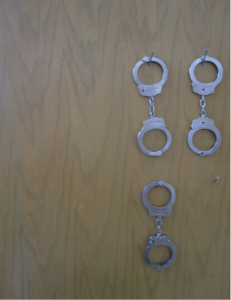 Many years ago, I was conducting a security assessment for a large urban public school district when I noticed three sets of handcuffs hanging on a wall in an office. The handcuffs seemed very out of place so I asked the alternative school director about them. I was pretty shocked to learn that the school had been using the handcuffs to secure disruptive students. I was advised that the handcuffs were being used in situations where no criminal charges were being filed against the students but instead were being used to restrain and control them until they calmed down.
Many years ago, I was conducting a security assessment for a large urban public school district when I noticed three sets of handcuffs hanging on a wall in an office. The handcuffs seemed very out of place so I asked the alternative school director about them. I was pretty shocked to learn that the school had been using the handcuffs to secure disruptive students. I was advised that the handcuffs were being used in situations where no criminal charges were being filed against the students but instead were being used to restrain and control them until they calmed down.
The director noted that one pair of handcuffs was missing and unaccounted for, and that he was concerned about the missing handcuffs. I was much more concerned about the manner in which the handcuffs were being utilized. I advised the director that it would be wise to immediately cease using the handcuffs, have them removed, and to retrain his staff post haste. I also suggested he consider having his staff trained in de-escalation and passive restraint techniques. The way the handcuffs were being used was a “CNN moment” and litigation waiting to happen. Many of the most problematic things we have found during school security assessments do not appear on any school security assessment checklist. Rather, they are the types of bizarre situations that will only be seen once or twice in an entire school safety career.
When I encounter such startling practices in K12 schools, I am often amazed that a major scandal has not already erupted. In one mid-sized school district, the school district police chief had instructed his officers that they could not search students for firearms unless they had probable cause. This measure was implemented due to fears of litigation. School police officers began making it a practice to wait outside the administrator’s office while the unarmed and untrained school officials conducted extremely dangerous searches. This was being done even though there are a number of appellate court cases making this unnecessary. After more than a year had passed, school police learned that one male middle school administrator had been having male students take off all of their clothing except their underwear as a standard practice when he searched students for weapons, drugs and tobacco. The reaction to the fear of being sued set the district up for what could have been a pretty solid civil action and an embarrassing media festival. The district was fortunately able to stop the practice before this happened.
Being alert to unusual sights and practices when conducting school security assessments can be pretty important. There are many situations where there is a reasonable explanation for something that at first appears to be abnormal. The types of situations described above can sometimes be identified and corrected if school security assessments are not focused simply on the standard “locks, doors and hardware” approach. Looking beyond the checklist for situations that do not fit with the norm can be incredibly important.